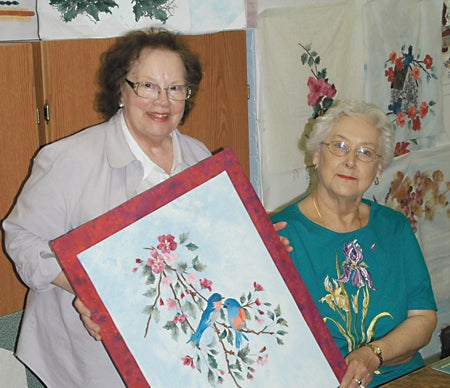Leatz demonstrating appliques Friday
Published 10:14 pm Wednesday, May 8, 2013
Ann Leatz is a quilter whose technique relies on appliques, smaller ornaments applied to another surface.
Her hand-made elements make each unique, like a cloth snowflake.
Most of what she makes for A to Z Designs in the basement of her Main Street home gives flat flowers, leaves, even stones, a three-dimensional feel.
But it also lends itself to scenes, such as the farm on California Road where she and her two artistic sisters grew up immersed in the arts decades before the Dogwood Fine Arts Festival.
“Millie’s Bouquet,” at Underwood Shoe Store, will be featured as part of Dogwood’s Up Front Art Walk.
“I’ve been doing it 54 years. That’s all,” she said Tuesday. “I started in ’60, just horsing around with a quilt my aunt was making. Ron and I married in October ’61 and I squirreled away $29.95 to order an applique tulip quilt out of Better Homes and Gardens. That was the start of it,” which includes 23 years traveling the country, putting on shows and teaching students.
“My sister is a world-class ceramist. My other sister is a professional watercolor artist. And I’m in textiles,” Leatz said. “All three of us farm girls do something in the arts because Mom and Dad had a tremendous standard for fine arts and music. We all took music lessons. As a youngster 3 years old, I started with my hands getting caught in different things — the cream separator, grinder and plow hitch — but they do not bother me.”
“She was a guest at our May luncheon last year,” Wegner said, “and she came to me afterward and offered to do a program this year. I also had her speak at Antlerettes at the Elks.”
Where “Blossomtime” with two robins resonates with southwest Michigan denizens, “Southern Charm” was inspired by a magnolia tree at a retreat in northern California. “Circle Memory” was done for her daughter, who likes pansies (“very difficult to do”), with forget-me-nots.
“I use the whole method,” Leatz said. “I applique pieces together first, then apply them to the fabric. When I want to make a visual impact, I lay the blossoms out first. In this one, ‘Ann’s Apple Vine,’ because I don’t know what else to call the darn thing, the leaves are in two parts, sewn together, then put down onto the background. That’s kind of unique because a lot of people don’t like to work with one color. ‘Waiting for Mama’ studies little birds and nests. I make a window template of every piece in the design and peruse it over tie-dyed cloth to find a vein, so a person looking at it sees a leaf. It’s all hand done. No machines.”
Sometimes she makes several versions until one satisfies her.
“An average person wouldn’t do that, but I go the extra mile so my students can see from where I began to where I end up,” she said. “The trick is getting something flat, like this jug, to look round.”
Flowers such as primroses, tulips and grape hyacinths are often depicted with root systems, which she painstakingly cuts from a single piece.







